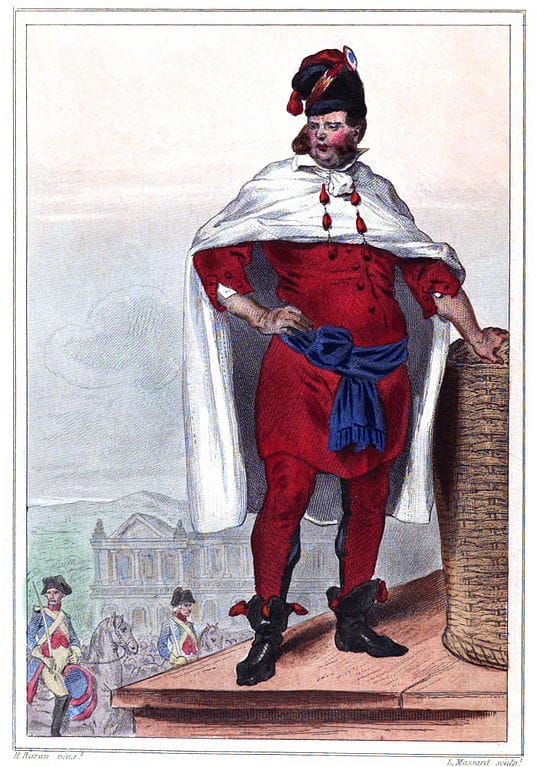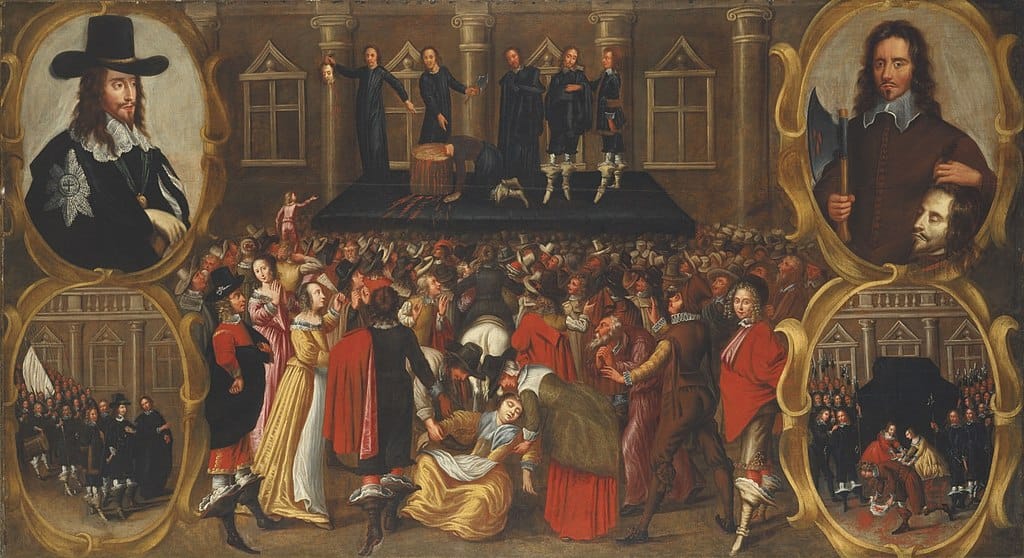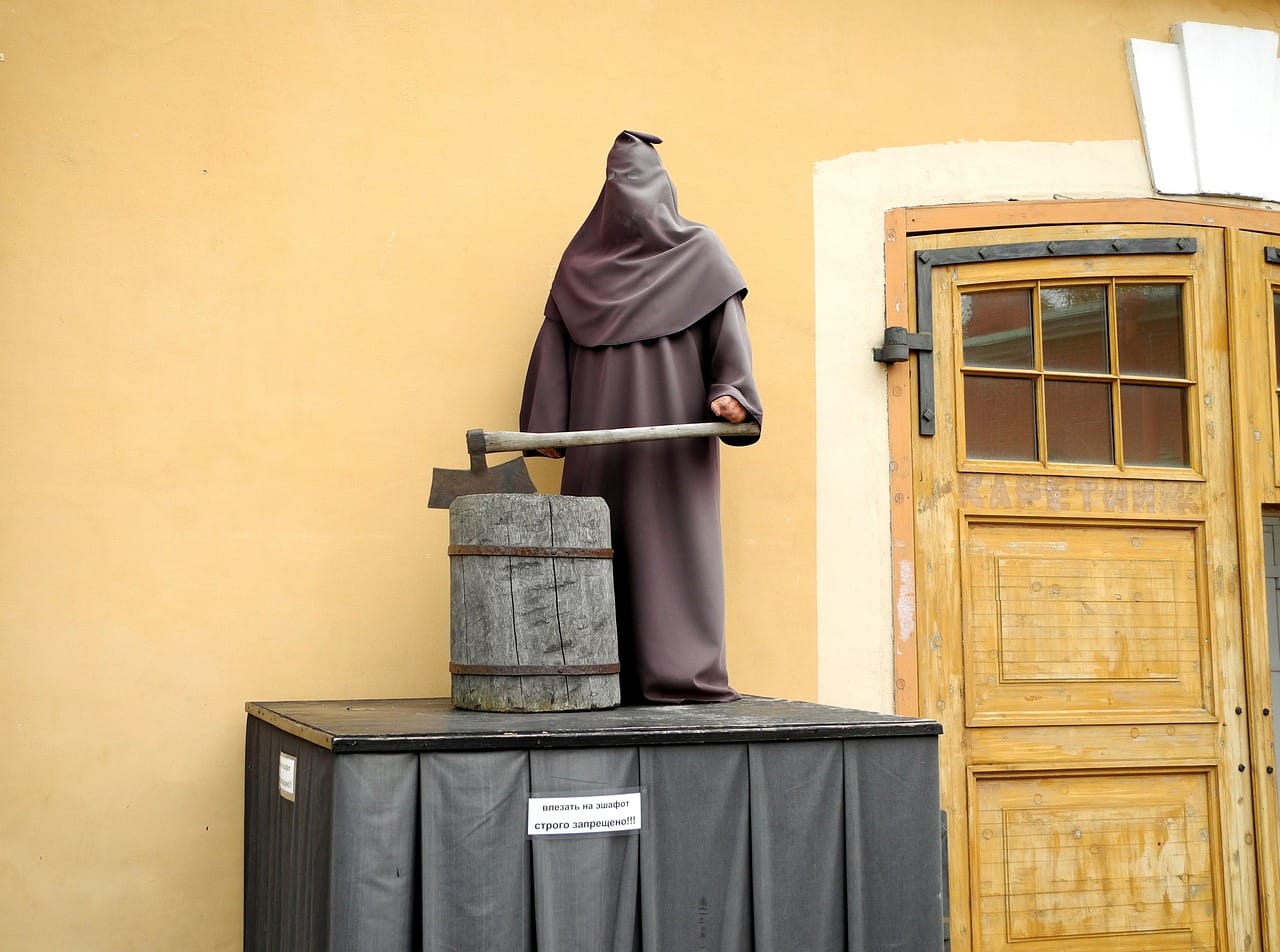In popular culture, the image of an executioner is widespread, whose face is hidden under a mask or hood. We decided to check whether this was really part of the executioner's uniform.
Executioners are often depicted wearing masks in films - and not only in historical ones. Thus, the mask is worn by the executioners who executed Anne Boleyn in "Tudors» and Ned Stark in "Game of Thrones», as well as the executioner who was supposed to cut off the head of the hippogriff in "Harry Potter and the Prisoner of Azkaban». At the executioner from the cartoon "Ilya Muromets and the Nightingale the Robber» the face is covered with a hood with slits for the eyes. The executioner in the game looks similar Alice: Madness Returns. This image can meet V TV show. Figures executioners wearing masks or hoods is a common attribute museums medieval torture all over the world. This is how they dress animators on thematic events And reenactors.
We were unable to find in historical documents evidence the fact that the executioners wore masks during executions. Moreover, in medieval and later engravings and paintings, the faces of the executioners are usually open: this is how the execution is depicted Anne Boleyn, Mary Stuart, Jacques de Molay and his Templar brothers, Robespierre And many other executions. None of the many characters in the film are wearing a mask. engraving, depicting the execution of François Ravaillac, the murderer of Henry IV.
Hannele Klemettilä, a historian specializing in the Middle Ages, has researched the image of executioners in literature, historical documents and visual arts. In her book Evil Incarnates: Portrayals of Executioners in Northern France and the Netherlands in the Late Middle Ages, she writesthat the now popular image of an executioner, whose face is hidden by a deep hood with slits for the eyes, is also found in Italian legal illuminated manuscripts of the late Middle Ages, so, apparently, the executioners there actually hid their faces. This is due to the fact, the historian writes, that in small towns in Italy at that time there was often no separate person performing the functions of an executioner. Therefore, death sentences were carried out by members of the secular fraternity, which included responsible and high-ranking citizens. Sometimes it was the same person who made the verdict. It is clear that they wanted to remain anonymous in order to avoid retaliation from the relatives of the executed person and the censure that professional executioners usually felt. In France and Burgundy, where the executioners were official persons, no one wore any masks - and in the fine and other arts no one attributed them to them either. Moreover, wearing masks in the Middle Ages was condemned by the church and was considered a devilish and pagan phenomenon. For a person who guards the law, this was unacceptable.

Nevertheless, they are found in museums exhibits, which are described as masks of medieval executioners, but some of them are already recognized a late hoax.
But why would the executioners hide their faces at all? It is assumed that it was a disgraceful profession and they wanted to remain anonymous. Yes, these people really were often social outcasts, however, their identity was by no means a secret. Firstly, this type of activity was often transferred by inheritance - to the point that the daughter of one executioner could only marry the son of another. In fact, the executioner's son often had no choice: continuing the family business was the only available way to earn money. They tried not to communicate with the executioners, often they didn’t even want to take money from them, their children were not accepted into schools. This almost caste system would not have developed if the identities of the executioners were a secret. Secondly, executioners, despite their socially disapproved occupation, had some privilege. So, for example, they could take food for free from local markets, and for this, of course, the traders had to know them by sight.
Henri Sanson, representative of one of the most famous French executioner dynasties, left after myself diaries, where he mentioned that one of his ancestors was offered to sew a “serious suit” for executions, but “Charles-Henrich Sanson rejected the honor of such attire and expressed a desire to remain in the clothes that he wore.” That is, in fact, the executioner did not have any special uniform. In his diaries, Sanson describes in sufficient detail the life and professional activities of the executioner, but never mentions masks.
Joel Harrington, a historian at Vanderbilt University in Tennessee and author of The Faithful Executioner: Life and Death, Honor and Shame in the Troubled 16th Century, speaks: “Forget about this image of an anonymous, sadistic executioner in a hood. They considered themselves law enforcement officers.”
Perhaps the image of a masked executioner entered the public consciousness from Alexandre Dumas’s novel “The Three Musketeers”: there the Lille executioner, who executed Milady, appears in a red cloak and mask. But he hides his face rather to intimidate and effectively remove the mask in front of Milady, who is already familiar with him, it was he who branded her in the past. When he removes the mask, it has a strong dramatic effect. He himself is clearly not hiding: he lives in a house on the outskirts of the city, passers-by Athos meets know about this and show him where the executioner lives, he does not hide his face when he opens the door to Athos.

The executioner who executed King Charles I in Dumas's novel Twenty Years Later also wears a mask. This is explained by the fact that the city executioner was kidnapped by the musketeers, and someone unknown took his place. At the same time, in the novel “Queen Margot” by the same Dumas, the executioner Kabosch is depicted without any masks, the heroes know him by sight.
The executioners of Charles I, apparently, really were wearing masks - this mentioned in many authoritative sources, not only Dumas. This was the first time in England that a king was executed, so it is not surprising that the executioners were afraid to show their faces. The son of the executed king, Charles II, having come to power, avenged his father. He convicted the 39 surviving members of parliament involved in the sentence of Charles I for regicide. Personalities executioners were never revealed. However, it is noteworthy that images execution of the king executioners no masks. Most likely, this is due to the fact that the artists were not present at the execution in person. They did not see the executioners, so they depicted them as they usually looked - with open faces.
Thus, sometimes executioners did wear masks, but this was more of an exceptional phenomenon, characteristic of certain localities or out-of-the-ordinary cases (such as the execution of some royals), rather than the rule. Typically, executioners performed their work with open faces, they were known, and this had both its disadvantages and significant benefits for the executioner himself.
Mostly not true
Read on the topic:
- Myths and truth in Dumas’ novel “The Three Musketeers”
- Is it true that medieval knights put chastity belts on their wives before leaving for war?
- Is it true that in the Middle Ages spiral staircases were twisted clockwise for the convenience of the defenders?
- Is it true that the brother of Louis XIV was kept in an iron mask in the Bastille?
If you find a spelling or grammatical error, please let us know by highlighting the error text and clicking Ctrl+Enter.






